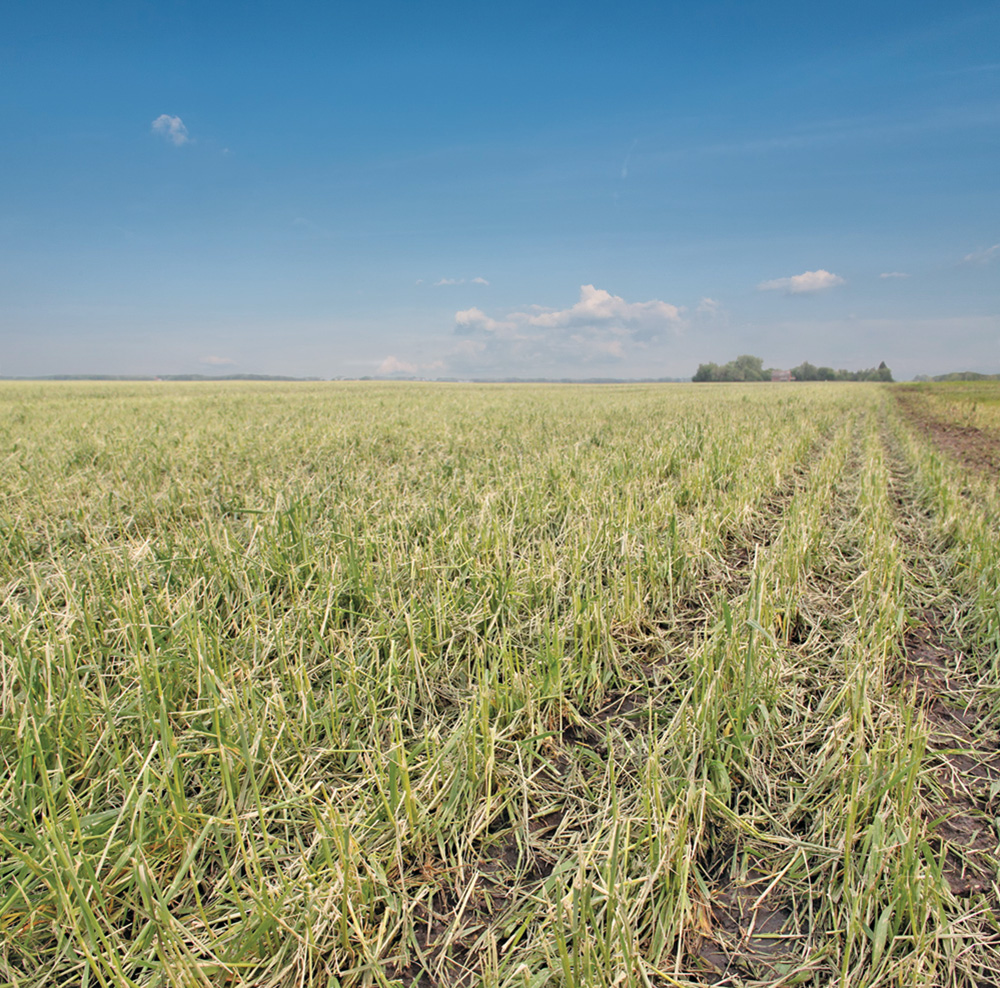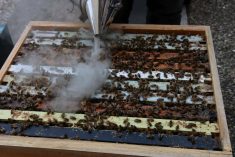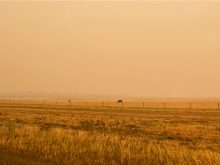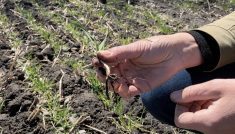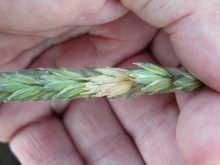[Updated: March 28, 2017] The Prairies suffered a record number of hail events in 2016, which means hail insurance claims are also at record levels, with more than $528.6 million paid out to western Canadian farmers.
Manitoba has set records for hail insurance claims two years running. The Manitoba Agricultural Services Corporation (MASC) received 3,747 payable hail claims in 2016 and has paid out $43.6 million. That topped the record 2,783 claims in 2015 that cost $31.1 million in payouts.
Alberta Financial Services Corporation (AFSC) paid out a total of just over $361 million for 6,022 claims for hail damage in 2016 under its straight hail and hail endorsement programs.
Read Also

Claas brings 1000 Series SP forage harvesters to Canada
In mid-August, Claas unveiled its new line of Jaguar forage harvesters at an event in Visalia, California, deep in the heart of that state’s dairy region.
Meanwhile, Saskatchewan insurers had paid out in excess of $124 million for over 11,001 claims by October 2016, which is also up significantly from 2015.
The Florence Nightingale effect
When hail hits it often provokes a “Florence Nightingale” response, as farmers try to figure out what they can do to restore or save their ravaged crops. That can lead to emotional rather than economic decisions, and farmers may be tempted to try some of the growing number of new products.
“There are an increasing number of products with hail rescue claims and I’m hearing more often from farmers that they’d like to know if there’s any merit to them because it’s very emotional when they are dealing with a nice crop and it gets injured,” says Ken Coles, general manager of Farming Smarter. “They want to make decisions about how to manage that damaged crop based on real evidence.”
To date, a lot of the evidence about whether these products actually make a difference to a hail-damaged crop has been anecdotal, says Coles. The Canadian Food Inspection Agency doesn’t require any efficacy testing for some nutrient-based products, which means companies can make certain claims as long as the product doesn’t harm the environment.
Coles has just completed the first year of a research project at Lethbridge and with SARDA (Smoky Applied Research and Demonstration Association) at Falher, Alberta to evaluate some of the products — fungicides and micronutrient blends — that carry hail rescue claims. Coles tested the products against untreated check plots in wheat, peas and beans to see what effect they have at different levels of hail damage and different plant growth stages.
Interestingly, it was the Alberta Pulse Commission who first stepped up to the plate with some funding for Coles’ project, probably as a result of some interesting stories from growers who had good results using a strobilurin fungicide on hail-damaged pea crops.
Coles had been seeking funding for a hail damage project for several years, but there was a perceived challenge in simulating hail damage effectively for a field-scale experiment. “To study this on a field scale is difficult because hail isn’t even,” says Coles. “It can be severe on one part of the field and taper off until it’s quite light within the same field. The other thing that bothered me was, how do to know that an applied rescue product wouldn’t have had the same impact on the crop without hail?”
How to simulate hail
First on the priority list was building a hail simulator that would be representative of actual hail damage in the field, and would convince funders that the project was worthwhile. Past simulators had always been projectile based, throwing rocks or ice, and hadn’t done a great job of replicating actual hail damage. Coles worked with a team led by Ralph Lange at InnoTech Alberta, based in Vegreville, which had been working on developing a simulator for several years, and had found the thing that worked best to simulate true hail damage was flailing a dog chain.

Coles mechanized the concept and designed a rotary hail machine that uses chains, and is adjustable to produce different intensities of hail from 100 per cent defoliation to very slight damage levels around 25 per cent. “A local company built one and it worked really well. It was inexpensive to build, and we were able to effectively replicate different levels of damage, which gave us the ability to go ahead with the study,” says Coles, who had the chance to test the simulator in 2015 on some actual canola plots. The Alberta Financial Services Corporation is providing funding for the canola component of the project, which isn’t using any rescue products, to get a better understanding of yield potential after various levels of hail damage.
In 2016, the Alberta Wheat Commission also provided funding for a wheat component to the project.
Timing matters more than severity
Although results from 2016 are very preliminary, the biggest take-home message is that timing and crop stage during a hailstorm is vitally important. “We are discovering that the level of damage doesn’t matter nearly as much as the timing of damage. It differs for different crops but hail is going to be more manageable in a crop, and there is a better opportunity for the crop to recover and produce yield, with an early hail,” says Coles. “We haven’t seen much potential for crops to recover with later hail damage. I think it’s going to be a matter of understanding when the damage happened, and whether the crop was at a particularly vulnerable stage to determine if there is a chance of recovery.”
In both canola and wheat, Coles saw significant recovery and regrowth, even in severely hail-damaged plots that received no rescue products, when the hail was received in mid- to late June (up to the early-heading stage). In plots that received hail damage by mid-July there was very little recovery and significant yield losses. Coles saw little difference in the wheat plots that had received the fungicide (Prosaro) or the micronutrient product (Alpine).* “We did see glimmers of possibilities of the rescue product working in certain circumstances, for example, after the June 29 hail treatment, the plots with the fungicide application seemed to have cleaner leaves and there was less tan spot than on the untreated check plot. But I am cautious in jumping to any conclusions about these products until we have more years of data.”
Helping farmers manage hail damage
In the future it could be possible to collect remote-sensing data using drones or satellites and develop an algorithm to predict the extent of hail damage and recovery potential for a particular field that farmers could use when negotiating hail insurance claims. But that’s still a bit of a pipe dream, and in the meanwhile, Coles is focusing on producing hard data about hail damage and plant recovery that will help farmers make better management decisions.
“We’re going out and beating up crops in a consistent and replicated way. It’s really controlled and hard to argue with,” says Coles. “Damage is damage and when we’re able to statistically pull out differences in even something as simple as the crop timing that gives us a lot of power and confidence in what we can say because we are taking a science-based approach.”
One of the biggest challenges with a hail-damaged crop is with split maturity, says Coles. “A hailstorm can result in more tillering, so farmers will have half of their crop mature and ready to harvest and the other half is behind,” he says. “There isn’t really any good advice out there about how to manage that except for traditional farmer experiences. We are hoping that we can eventually provide some insight into whether to desiccate or not based on the likely yield potential of the crop following a hail event.”
Weeds also become an issue following a hail event, as they compete with new plant growth. “In particular in wheat, when you get a later hail it opens up the canopy so light can penetrate, which gives an opportunity for weeds to take off,” says Coles. “If somebody suggests spraying micronutrients or nutrients on at that stage, they could be fertilizing the weeds, which could be a negative consequence of late application.”
As hail claims increase, so do premiums for hail insurance, which means farmers will continue to invest more and more money in these programs to try and offset the cost of hail damage. Meanwhile, Coles and his team are working hard to try and come up with recommendations that can make an economic impact and help relieve some of the stress when farmers experience hail damage. “Hail is really complicated, and just being able to get out there, and study, and observe and see what happens we hope will shed light on other management practices that farmers can use,” says Coles.
*This article originally included wording implying that Bayer’s Prosaro fungicide carries a hail rescue label claim. It does not. We regret the error.


